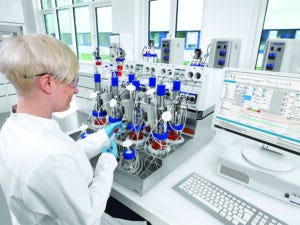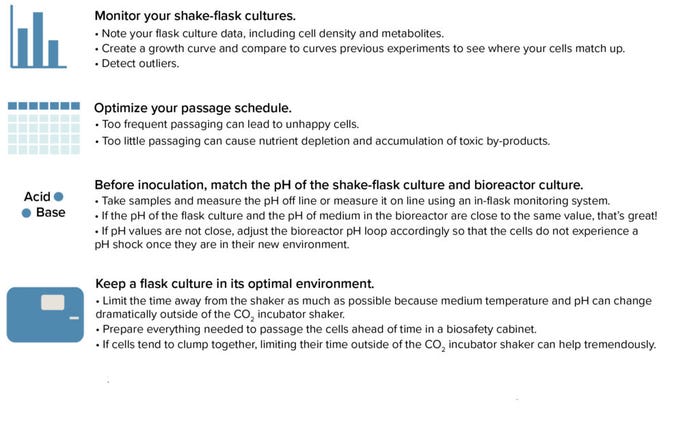- Sponsored Content
- Cell Culture Media
Increasing Reproducibility of Cell Culture BioprocessesIncreasing Reproducibility of Cell Culture Bioprocesses
Sponsored by Eppendorf

Using parallel systems such as the DASbox minibioreactor system helps to increase reproducibility between bioprocess runs.
Reproducible cell growth and reliable development of a desired product are ideal outcomes for a bioprocessing engineer. If reproducibility is poor, the risk of needing to discard a batch and repeat an entire bioprocess is high and results in a great loss of time and resources. Cells, culture media, and a bioprocess control system are required components of an upstream bioprocess. Each of those can be a source of variability that affects cell growth and viability as well as product formation and quality.
Below, I ask experts at Eppendorf to describe the factors that can contribute to inconsistent results and explain how to increase the reproducibility of cell culture bioprocesses. Amanda Suttle is a bioprocess senior research scientist in the Eppendorf applications laboratory in Enfield, CT. Robert Glaser is an applications laboratory manager at the Eppendorf Bioprocess Center in Jülich, Germany.
Inoculum Quality
How can we improve the quality consistency of the cells used to inoculate a bioreactor?
Suttle: In upstream bioprocessing, cells must be kept in an optimal state from initial thaw to bioreactor-culture phase. That is even more essential when designing a scale-up process to achieve matching growth curves and production yields from shaker- to pilot-scale production. In our experience, inoculum quality is of primary importance.
Reproducible cell growth and yields start in shake-flask culture. One of my company’s ways to achieve a perfect inoculum is to maintain cell viability at ≥95% in our prebioreactor culture so that the cells remain in optimal condition at the time of inoculation. By keeping constant limits in our experiments, we obtain reliable and predictable data.
In initial phases of process development, establishing a standardized protocol is important. That includes setting an optimal passage schedule and monitoring the time that a culture is out of a shaker, thus minimizing pH and temperature variation. Maintaining those parameters throughout a process reduces metabolic disruption that could create a lag in bioreactor-culture growth. Establishing the same culture conditions with tight parameters will improve reproducibility across runs and facilitate scale-up, resulting in consistent cell-growth curves and yields.
As cells consume nutrients and generate by-products, medium composition changes, which can change cell behavior. Biomanufacturers must find ways to decrease the variability of cell growth, product formation, and product characteristics caused by such effects.
Glaser: Gaining an understanding of your bioprocess is critical to reducing variability. You can gain information about your process by implementing process analytical technologies (PAT). For example, exhaust gas analyzers, optical density sensors, and capacitance sensors can provide information relevant to cellular metabolic status. Raman spectroscopy and other techniques can provide information about the concentrations of nutrients and by-products.
With the appropriate bioprocess control software, a biomanufacturer can acquire data in real time and use those data to implement feedback loops. For example, culture feeding can be automated based on glucose concentration in a medium. Achieving more consistent conditions dramatically reduces the level of stress on cells, forming a sound foundation for optimal performance.

Figure 1: Tips for obtaining a high-quality inoculum.
Equipment
How can bioprocess equipment increase reproducibility of an upstream process?
Glaser: During process development, it is essential to evaluate reproducibility across different scales. At laboratory scale, parallel bioprocess systems can help developers achieve reproducibility. Parallel systems facilitate the simultaneous use of multiple bioreactors under identical conditions and using medium and inoculum from the same batches. For example, the DASbox minibioreactor system enables parallel processing of up to 24 vessels.
Parallel bioprocess systems can increase reproducibility across runs. Reproducibility of cell growth and product formation also should be attained across different scales. During bioprocess scale-up, bioprocess engineers handle different equipment, and each piece of equipment has its own characteristics. Flasks come in different materials, geometries, and scales; shakers have different orbits; bioreactors differ in materials, scales, and geometries; and assemblies have different types of impellers. Using a family of equipment with constant characteristics across scales will simplify scale-up from laboratory to pilot and production scales, thereby substantially augmenting the probability of reproducible results.
Sensors
Sensors are indispensable for gaining information about a process and for controlling parameters at set points. Can you provide some insight on how they can affect process reproducibility?
Suttle: To deliver reliable readings, bioprocess sensors need to be well maintained and precisely calibrated. For example, when implementing a process, biomanufacturers must keep procedures for dissolved oxygen (DO) sensor calibrations consistent, including parameters such as polarization time and calibration duration. Such procedures can differ significantly among sensor users. One way to increase reproducibility is to use bioprocess software features for guided calibration. For example, the new autocalibrate feature of BioFlo 320 and BioFlo 720 bioprocess controllers automatically polarizes and calibrates DO sensors according to a user’s preferred calibration methodology, thus providing reproducible results every time.
Using digital sensors and the bioprocess controllers capable of handling them simplifies sensor quality control. Digital sensors can be programmed to indicate when the end of their lifetime is near or when they need maintenance, thereby ensuring good sensor quality and reliable readings.
Troubleshooting
Consider a thought experiment: You are a research scientist in a biotechnology company. If you observe that cell growth and product yield of your bioprocess vary from day to day, what would be your first troubleshooting steps?
Glaser: There are different sources for variation. Typically, I would follow a risk-based approach using a brief failure mode and effects analysis (FMEA) to obtain an overview focusing on critical and insignificant topics. I would not make changes alone. At minimum, I would use the four-eyes principle, which requires that two people approve an action before it is taken. The cause of the problem might be based on something technical or biological, but I would home in on the most obvious and accessible targets. I would start with the most likely technical issues by investigating bioreactor connections to the controller. A common failure is that sensors or gas links are not well connected because of stress during setup. Even media conditions could cause problems if pump head tubings are not properly installed.
Next, I would investigate what the control software shows. It is crucial to have a software package that provides deep and detailed insights into bioreactor performance. That analysis begins with an overview of gas flows and concentrations for DO and pH control as well as PID (proportional, integral, and derivative) settings, controller behavior, base and media feeds, connected on-line and in-line PAT, and off-line data reports. It is important to think about what predicted behavior is anticipated and, if possible, compare process data with historical runs even when evaluating a new process design.
Look for changes in workflow. Was there a change in feed compositions or feed conditions? For example, did someone place feed in the refrigerator, instead of at room temperature? Are components stable for the conditions?
Also determine whether a system is being serviced regularly. With increasing age, sensors and actuators deteriorate, leading to deviations. That effect can be minimized by regular calibrations and adjustments.
Many types of failure can bring down a system, so it is important to have the right tool set at hand and enough good quality data to pinpoint the cause of variability.
Ulrike Rasche is scientific communications manager at the Eppendorf Bioprocess Center in Jülich, Germany; [email protected]. Amanda Suttle is senior research scientist, bioprocess in the Eppendorf Applications Lab in Enfield, CT. Robert Glaser is an applications laboratory manager at the Eppendorf Bioprocess Center in Jülich, Germany; [email protected].
You May Also Like





